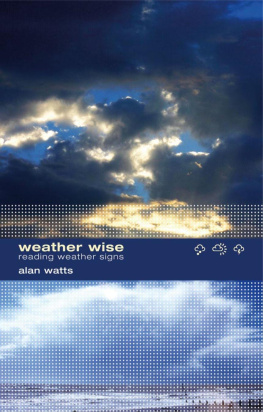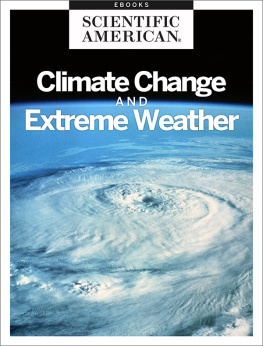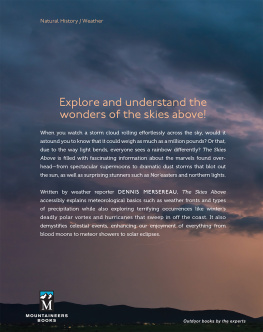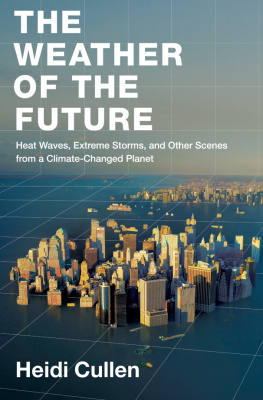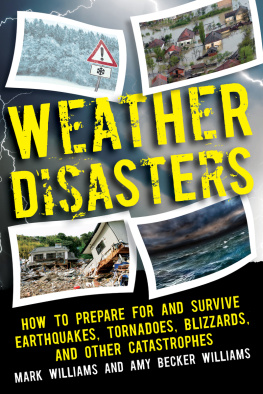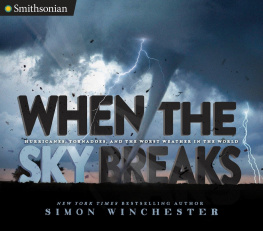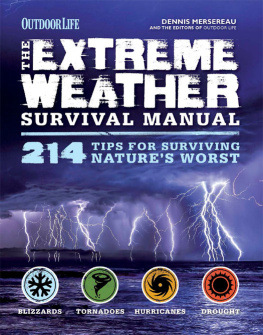Contents
Guide
Chris St. Clair
Former Host of the Weather Network
Weather Permitting
Twenty-Five Years of Ice Storms, Hurricanes, Wildfires, and Extreme Climate Change in Canada

A Division of Simon & Schuster, Inc.
166 King Street East, Suite 300
Toronto, Ontario M5A 1J3
www.SimonandSchuster.ca
Copyright 2022 by Roy Douglas Todd St. Clair
All rights reserved, including the right to reproduce this book or portions thereof in any form whatsoever. For information, address Simon & Schuster Canada Subsidiary Rights Department, 166 King Street East, Suite 300, Toronto, Ontario, M5A 1J3.
This Simon & Schuster Canada edition November 2022
SIMON & SCHUSTER CANADA and colophon are trademarks of Simon & Schuster, Inc.
For information about special discounts for bulk purchases, please contact Simon & Schuster Special Sales at 1-800-268-3216 or .
Interior Design by Wendy Blum
Cover Illustrations: Getty Images
Back Cover Author Photo Courtesy of the Weather Network
Back Flap Author Photo Courtesy of the Author
Library and Archives Canada Cataloguing in Publication
Title: Weather permitting : twenty-five years of ice storms, hurricanes, wildfires, and extreme climate change in Canada / Chris St. Clair.
Names: St. Clair, Chris, author.
Identifiers: Canadiana (print) 20220211906 | Canadiana (ebook) 20220212066 | ISBN 9781668002889 (softcover) | ISBN 9781668002896 (ebook)
Subjects: LCSH: CanadaClimate. | LCSH: Severe stormsCanada. | LCSH: Natural disastersCanada. | LCSH: Climatic changesCanada.
Classification: LCC QC985.S234 2022 | DDC 551.6571dc23
ISBN 978-1-6680-0288-9
ISBN 978-1-6680-0289-6 (ebook)
The whiskered face was drawn and tired. A half-smoked cigarette was tucked behind his ear. He looked older than his fifty years. The clothes he wore were oil stained and dirty and hung loosely on his frame. He was stooped forward. His calloused hand was outstretched; it held a chocolate bar.
The youngsters father stood beside her and nodded his approval. She took the gift.
The old man rose to his feet and faced the father. Both men had tears in their eyes as they slowly shook hands and patted each other on the back.
Thank you.
The old man would provide free gas, a kind word, help, and comfort to hundreds of evacuees from Fort McMurray that weekend.
This book is for you, and anyone else who has helped or been helped in time of need.
First Nations peoples have a special relationship with the earth and all living things on it. This relationship is based on a profound spiritual connection to Mother Earth that guided Indigenous peoples to practice reverence, humility, and reciprocity. It is also based on the subsistence needs and values extending back thousands of years. Hunting, gathering, and fishing to secure food for self, family, elderly, widows, the community, and for ceremonial purposes. Everything is taken and used with the understanding that we take only what we need and we must use great care and be aware of how we take and how much of it so that future generations will not be put in peril.
A SSEMBLY OF F IRST N ATIONS
INTRODUCTION
H i, Im glad youre here is how I would begin almost all my broadcasts as Canadas weatherman. For more than twenty-five years, I was a host on The Weather Network and reported on the countrys major weather events for the CBC, too. The job took me from coast to coast, surveying snowstorms, ice storms, hurricanes, and heatwaves. It also gave me the privilege of speaking to Canadians and asking them how they were shaped by these often brief but massive disruptions to the environment and climate. For some, these events were life-changing.
My fascination with the weather began as a child living in Nova Scotia, on the shores of Bedford Basin. The long arm of Halifax Harbour reaches inland, and Bedford Basin is a large bay, 8 kilometres long and 5 kilometres wide. Hills rise from three sides of the basin; Rockingham and its hillside homes lie on the west shore. On many days the Basin would disappear into the fog and the foghorns would blare, their sound and echo dulled in the mist. On certain evenings the fog would literally roll up our street, and my friends and I would ride our bikes in and out of its shroud. Fog is, hands down, my favourite type of weather.
During the summer and fall, my family often took a drive to Peggys Cove. Wed climb over the rocks and explore the area, always watching the ocean. We knew to play only on the light-coloured rocks and to never go near the dark-coloured ones, which were slippery and wet. The warning plaques hadnt been erected then, but those who lived by the sea knew where not to venture.
In the fall, the air would cool, and sometimes there were strong storms when the rain would come in torrents and the wind would bring down tree branches. The strongest seemed to arrive around Thanksgiving, and would remove the last colourful leaves. I remember the occasional power outage, but hurricanes and tropical storms were less frequent then. But I was in Peggys Cove in 1971 when Hurricane Beth hit the province. My sisters and I were standing in our raincoats eating cookies, and through the sweeping wind and rain we watched the massive swells burst against the rocky shore beyond the lighthouse.
Winters on the east coast were always long and varied. Snow, sometimes a lot of it, was usually followed by a thaw and rain. We struggled to keep a skating rink in our backyard and a snow fort by the driveway. The frequent winter thaws meant that sledding and skiing were intermittent activities, but they brought my friend, fog, and the eerie nights when the street lamps cast a diffuse orange glow on the city.
I attended Duc dAnville Elementary School, and it was there that my love for history and geography began. The school was named for the French explorer whose fleet of forty-four vessels hobbled into Bedford Basin in 1746 while on an expedition to recapture Louisbourg and Acadia from the British.
Thousands of crew were sick with scurvy, typhus, and typhoid, diseases they would spread to the local Mikmaq and Acadian communities. Most of the expedition, including the Duc dAnville, perished and were buried near Birch Cove, not far from where I lived. I knew those forests and shorelineI played there as a child and wondered what it must have been like back then.
In grade four, we were taught about the Halifax Explosion, the largest human-made explosion before the atomic bombing of Hiroshima in 1945. On December 6, 1917, at the height of the First World War, the SS Mont-Blanc, a French cargo ship laden with explosives, collided with the SS Imo from Norway, obliterating the north end of Halifax and leaving 9,000 injured and 2,000 dead. At the time only 65,000 people lived in Halifax, and a significant portion of the population was made instantly homeless. To further compound the tragedy, in the hours following the blast, a massive blizzard struck the Maritimes and Nova Scotia particularly hard. So interesting to me then was how the hilly terrain deflected the initial shockwave from much of the southern half of the city, which saved so many lives. History and geography.


